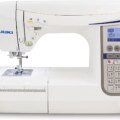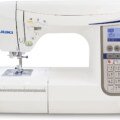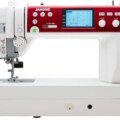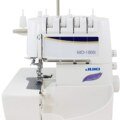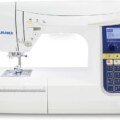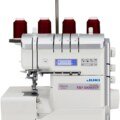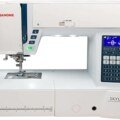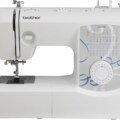- Sewing Machines
- Electronic Sewing Machine
- Review of Juki TL-2010Q Sewing Machine for Quilters
Review of Juki TL-2010Q Sewing Machine for Quilters



Specifications
General
| Best For | Beginners |
| Status | Available |
| Manufacturer | Fabric Hut |
| Model Number | MO-735 |
| Country of Origin | Japanese |
| Warranty | limited warranty period |
Body & Display
| Material | Metal |
| Color | White |
| Style | N/A |
| Weight | 1 pounds |
| Dimensions | 25.7 x 14 x 18 inches |
| Portable | Yes |
| Assembly required | No |
| Included Components | N/A |
Technology
| Power Source | Treadle Powered |
| Wireless Lan | No |
| Built-in Software | No |
| LED Lighting | Yes |
| Batteries required | No |
Is the Juki TL-2010Q Worth the Price for Quilting? Find Out!
Choosing the right sewing machine can make all the difference in quilting. One standout option for quilters is the Juki TL-2010Q, which has garnered praise for its precision, speed, and reliability. Whether you are a beginner quilter or a seasoned professional, this review will delve into all the features, performance, pros, and cons of the Juki TL-2010Q sewing machine to help you determine if it is the right fit for your quilting projects.
Juki TL-2010Q Review for Quilting: An Overview
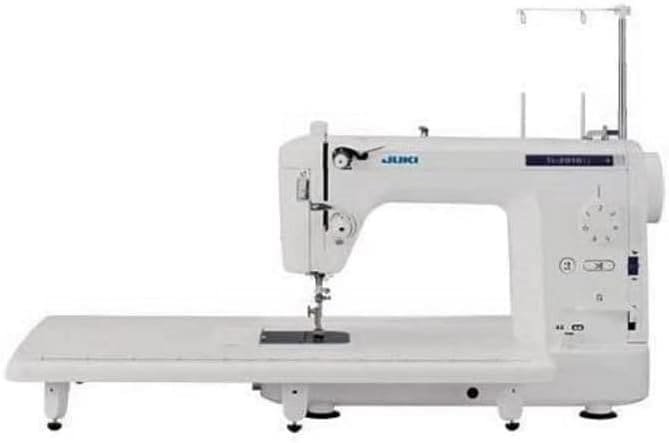
The Juki TL-2010Q is a high-performance, straight-stitch-only machine explicitly designed for quilters. It’s often regarded as one of the best straight-stitch sewing machines for quilters due to its incredible speed, precision, and ability to handle large quilt projects. Its industrial design and user-friendly interface make it a popular choice for both hobbyists and professionals.
Juki, known for its durable and efficient industrial machines, has brought that legacy to the home sewing market with the TL-2010Q. The machine excels at free-motion quilting, piecing, and straight stitching, making it a favorite among those who focus on intricate quilting techniques.
Now, let’s start the Juki TL-2010Q sewing machine review:
Quick Specs
These quick specs provide an overview of the Juki TL-2010Q’s core features. They are ideal for quilters who need high-speed, precision, and durable performance for quilting projects.
- Type: Straight-stitch sewing machine
- Maximum Sewing Speed: 1,500 stitches per minute
- Throat Space: 8 ½” x 6″ inches (wide workspace for large quilts)
- Stitch Type: Straight Stitch only
- Needle Position: Center needle position
- Presser Foot Lift: Automatic, with adjustable height
- Motor: 100W, high-power motor for efficient stitching
- Foot Pedal: Includes speed control for variable stitching
- Thread Cutter: Automatic thread cutter (both top and bobbin threads)
- Lighting: LED lighting for clear visibility
- Shank Type: High shank (compatible with high-shank presser feet)
- Max Stitch Length: 6mm
- Weight: 25.4 Pounds (11.52 KG)
- Dimensions: 14″D x 25.7″W x 18″H
- Presser Feet Included Walking foot, quilting foot, open-toe foot, patchwork foot
- Bobbin System: Drop-in bobbin system
- Extension Table: Yes, included for large quilt projects
- Thread Tension: Adjustable thread tension dial
- Additional Features: Speed control, adjustable presser foot pressure, bobbin winder, reverse stitch lever
Key Features of the Juki TL-2010Q
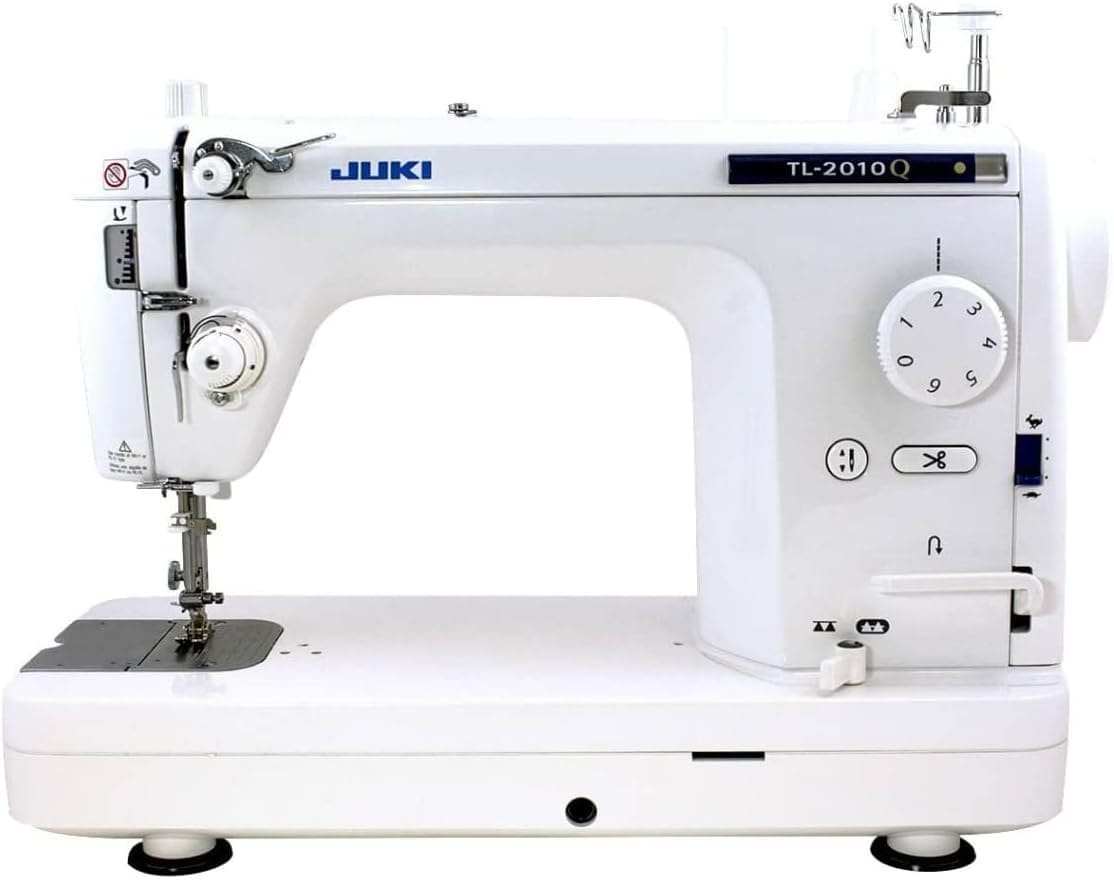
To help you make an informed decision, let’s break down the main features and performance capabilities of the Juki TL-2010Q:
- Speed Control: The Juki TL-2010Q can sew up to 1,500 stitches per minute. This high-speed capability ensures you can complete large quilt projects in less time. Still, it also comes with adjustable speed control, allowing you to slow down for detailed work like accurate piecing or free-motion quilting.
- Straight Stitch Only: This machine is designed for straight stitching only, which is ideal for quilters. While it doesn’t offer zigzag or decorative stitches, its simplicity ensures it excels at what it does best: creating flawless straight stitches with precision.
- Thread Cutter: One of the standout features of the Juki TL-2010Q is its automatic thread cutter. This mechanism cuts both the top and bottom threads with a push of a button, saving you time and hassle when transitioning between quilting sections.
- Ample Throat Space: The Juki TL-2010Q provides an expansive throat space of 8 inches, allowing you to easily maneuver large quilt pieces and manage significant projects without feeling cramped.
- Adjustable Presser Foot Pressure: For quilters working on different fabric types, the adjustable presser foot pressure allows customization to handle various materials easily.
- LED Lighting: The machine has bright LED lighting that illuminates the workspace, making it easier to see your stitches clearly, even during late-night sewing sessions.
- Walking Foot and Quilting Feet: The Juki TL-2010Q comes with a walking foot for even feeding multiple layers of fabric, which is essential for quilting. You’ll also find other helpful quilting feet, such as the quilting foot, open-toe foot, and patchwork foot.
- Foot Pedal with Speed Control: The Juki TL-2010Q’s foot pedal has a built-in speed control, allowing you to adjust the machine’s speed directly from the pedal.
Juki TL-2010Q Performance for Quilting Projects
When evaluating the performance of a sewing machine, quilters are concerned with stitch quality, speed, ease of use, and versatility. The Juki TL-2010Q doesn’t disappoint in any of these areas:
- Stitching Quality: The Juki TL-2010Q’s stitch quality is remarkable. Its straight Stitch is consistent, even at high speeds, which is crucial for quilting projects. It delivers sharp and precise stitches that quilters desire, particularly for scant 1/4-inch seams—a vital feature for creating perfectly pieced quilt blocks.
- Free-Motion Quilting: The Juki TL-2010Q performs exceptionally well in free-motion quilting. The machine can stitch in all directions, making it a top choice for detailed quilt designs. Its smooth feed mechanism ensures the fabric moves smoothly under the needle, resulting in even stitches.
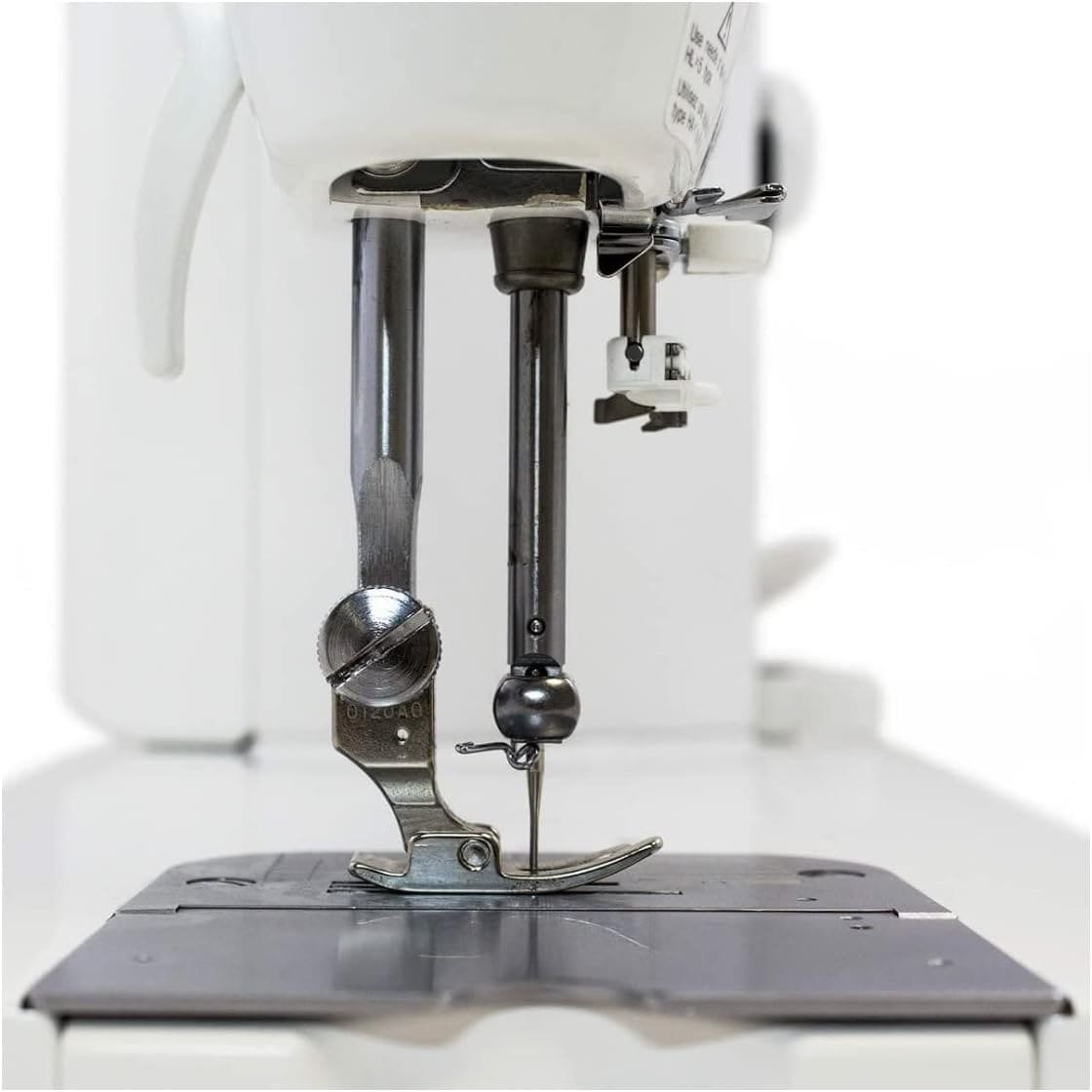
- Speed Control: Whether you need to go fast or slow, the Juki TL-2010Q’s speed control offers full flexibility. You can increase the speed for long seams and decrease it for intricate piecing or free-motion quilting.
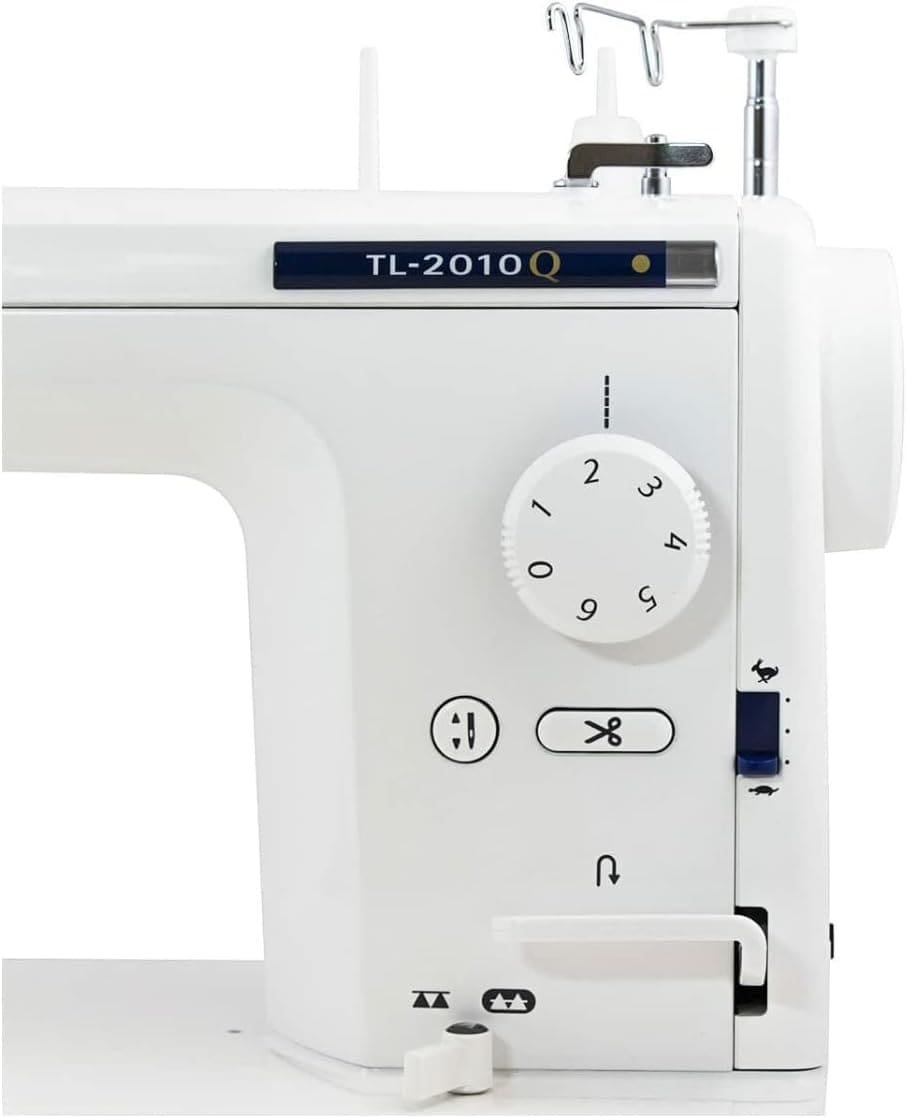
- Thread Tension: Adjusting thread tension on the Juki TL-2010Q is straightforward, with a dedicated dial for precise control. This ensures that your quilt’s top and bottom stitches align perfectly, producing professional-looking seams.
Is the Juki TL-2010Q Worth the Price?
The price of the Juki TL-2010Q is $999.
One of the biggest questions potential buyers ask is whether the Juki TL-2010Q is worth its price tag. While the machine has a higher price point than entry-level sewing machines, its features, durability, and performance make it a solid investment for serious quilters. The machine’s sturdy build, high-speed sewing, and advanced quilting features are worth every penny for those who value efficiency and precision in their projects.
If you’re looking for a machine that can easily handle small and large quilting projects, the Juki TL-2010Q is undoubtedly a top contender. Its robust performance in garment-making and large quilt projects makes it a versatile choice for quilters who are also interested in other sewing techniques.
Accessories of Juki TL-2010Q Sewing Machine

The Juki TL-2010Q comes with several useful accessories to enhance your quilting experience. These accessories include:
- Walking Foot: Ensures smooth fabric feeding for quilting and sewing multiple layers.
- Quilting Foot: Perfect for precision stitching in quilting projects.
- Open Toe Foot: Ideal for free-motion quilting or detailed designs.
- Needles: Comes with a set of needles suitable for quilting.
- Extension Table: Provides additional space for large quilts and fabric handling.
Juki TL-2010Q Troubleshooting and Common Issues
While the Juki TL-2010Q is highly praised for its performance, it can encounter a few issues like any machine. Here are some common problems and their fixes:
- Lighting Issues: Some quilters have reported dim or inconsistent lighting. To fix this, check the bulb and ensure it is seated properly. If the problem persists, replacing the bulb with a higher-quality LED can improve brightness.
- Thread Tension Problems: Improper threading or incorrect tension adjustments can lead to poor stitch quality. Consult the manual for thread tension adjustments, or try re-threading the machine carefully.
- Walking Foot Troubleshooting: If the walking foot isn’t feeding fabric evenly, check if it’s attached correctly or if the presser foot pressure needs adjustment.
Juki TL-2010Q vs. Other Machines: A Comparison
Many quilters wonder how the Juki TL-2010Q stacks up against other machines on the market. Here’s a comparison between the Juki TL-2010Q and some top competitors:
Juki TL-2010Q vs Brother PQ1500SL: Detailed Comparison for Quilters
Regarding high-quality sewing machines designed for quilting, the Juki TL-2010Q and Brother PQ1500SL are two highly regarded options. Both machines cater to quilters who need precision, speed, and versatility. However, each offers unique features that may appeal to different sewing preferences. Below is a comprehensive comparison table highlighting their key specifications and features.
Comparison of Juki TL-2010Q vs Brother PQ1500SL
| Feature | Juki TL-2010Q | Brother PQ1500SL |
|---|---|---|
| Brand | Juki | Brother |
| Model | TL-2010Q | PQ1500SL |
| Sewing Speed | 1,500 stitches per minute | 1,500 stitches per minute |
| Max Stitch Length | 6mm | 5mm |
| Stitch Types | Straight stitch only | Straight stitch only |
| Thread Cutter | Automatic | Automatic |
| Shuttle Type | Vertical | Vertical |
| Presser Feet Included | Walking foot, quilting foot, 1/4 inch foot, etc. | All-purpose foot, quilting foot, zipper foot, etc. |
| Knee Lift | Yes | Yes |
| Throat Space | 8 inches | 5.7 inches |
| Weight | 25.4 lbs | 24.2 lbs |
| Adjustable Presser Foot | Yes | Yes |
| Speed Control | Knob-controlled | Foot pedal-controlled |
| Free Arm | No | Yes |
| Warranty | 2 years | 2 years |
| Price Range | Higher-end | Mid-range |
Analysis and Opinion
- Sewing Speed: The Juki TL-2010Q and Brother PQ1500SL offer the same speed of 1,500 stitches per minute, which makes them both excellent for quilters looking for high-speed performance.
- Max Stitch Length: The Juki TL-2010Q has a slightly longer stitch length of 6mm compared to the Brother PQ1500SL’s 5mm. This gives the Juki a minor edge for longer, more detailed stitches.
- Throat Space: The Juki TL-2010Q offers an 8-inch throat space, larger than the 5.7 inches of the Brother PQ1500SL. This makes the Juki better suited for handling larger quilts or bulky projects.
- Presser Feet: The Juki has a walking foot, which is great for quilting and thicker fabrics. The Brother, however, provides a broader range of feet options, including an all-purpose foot, quilt foot, and zipper foot. The Brother might be a better fit if you’re looking for more versatility in feet options.
- Free Arm: The Brother PQ1500SL has a free arm feature, which makes it easier to sew sleeves or smaller tubular items. The Juki TL-2010Q does not have this feature, which might limit its versatility in some garment sewing projects.
- Knee Lift: Both machines have a knee lift, a fantastic feature for quilters. They also allow hands-free control for lifting the presser foot, making sewing large projects more manageable.
- Price and Value: The Juki TL-2010Q tends to be priced higher than the Brother PQ1500SL in terms of price. However, with its larger throat space and slightly higher stitch length, the Juki offers more features tailored to quilting enthusiasts who need precision and durability.
Which One to Buy?
Both machines are excellent choices for quilters, but your decision depends on your specific needs. If you require more throat space for large quilt projects and prefer a sturdy, high-performance machine, the Juki TL-2010Q is a fantastic option. On the other hand, if you are looking for a more versatile, budget-friendly machine with additional features like a free arm, the Brother PQ1500SL might be more suited to your preferences. Either way, both models offer exceptional value for serious quilters.
Juki TL-2010Q vs. Bernina for Quilting: The Bernina models are highly regarded for their versatility and quality. However, the Juki TL-2010Q offers a more affordable price point for quilters prioritizing straight stitches and speed. The Bernina is known for its extensive stitch options, while the Juki TL-2010Q excels at speed, precision, and comprehensive project handling.
Frequently Asked Questions
- Is the Juki TL-2010Q a high or low-shank machine? It is a high-shank sewing machine, meaning it can accommodate a wide variety of presser feet and attachments designed for high-shank machines.
- What is the speed of the Juki 2010Q? The Juki TL-2010Q has an impressive sewing speed of up to 1,500 stitches per minute, making it one of the fastest quilting machines available.
- What feet come with the Juki TL-2010Q? The machine comes with several feet, including a walking foot, quilting foot, open-toe foot, and patchwork foot, all designed to help quilters achieve professional results.
- What is the difference between Juki 2000 and 2010? The Juki TL-2010Q is an upgraded version of the Juki TL-2000Q, offering improved features like enhanced stitch quality, a more powerful motor, and a modernized design for better quilting performance.
Conclusion: Is the Juki TL-2010Q Worth the Price for Quilting?
The Juki TL-2010Q is an exceptional straight-stitch machine designed with quilters in mind. Its speed, precision, and durability make it perfect for those looking to tackle large quilt projects, free-motion quilting, or any other type of quilting that demands accuracy. While it may not have all the decorative stitch options of different machines, its performance in quilting is second to none. Whether you are a beginner or an experienced quilter, the Juki TL-2010Q is undoubtedly a machine worth considering.
Commonly Asked Question (FAQs) About Juki TL 2010Q
Can the Juki 2010Q sew leather?
The Juki TL-2010Q can take care of sewing leather-based, however with a few obstacles. It must be capable of sew skinny, smooth leathers like garment leather in a couple of layers. For thicker leathers or multiple layers, you might need to don't forget a sturdier system. The right news is the Juki comes with a special foot that allows it feed leather extra calmly.
Is the Juki 2010Q a high shank or low shank machine?
The Juki 2010Q is a high shank sewing machine. This means the attachment point for the presser foot, the piece that holds the foot onto the machine, is taller than on standard home sewing machines. So, when you buy extra presser feet for your Juki, look for ones specifically made for high shank machines.
How heavy is a Juki TL2010Q?
The Juki TL2010Q weighs around 39 pounds, which is a bit lighter than a carry-on suitcase. It's considered a portable machine, but it's sturdy because it's made of metal to handle tough sewing projects.
What feet come with the Juki TL 2010Q?
The Juki TL 2010Q sewing machine comes with four different feet to help you with various sewing tasks. You'll get a regular presser foot for basic sewing, a zipper foot for neat zipper application, a walking foot for feeding fabric layers evenly, and a free-motion quilting foot for creative stitching and embroidery.
What is the speed of the Juki 2010Q?
The Juki TL-2010Q has an impressive sewing speed of up to 1,500 stitches per minute, making it one of the fastest quilting machines available.
What is the difference between Juki 2000 and 2010?
The Juki TL-2010Q is an upgraded version of the Juki TL-2000Q, offering improved features like enhanced stitch quality, a more powerful motor, and a modernized design for better quilting performance.

